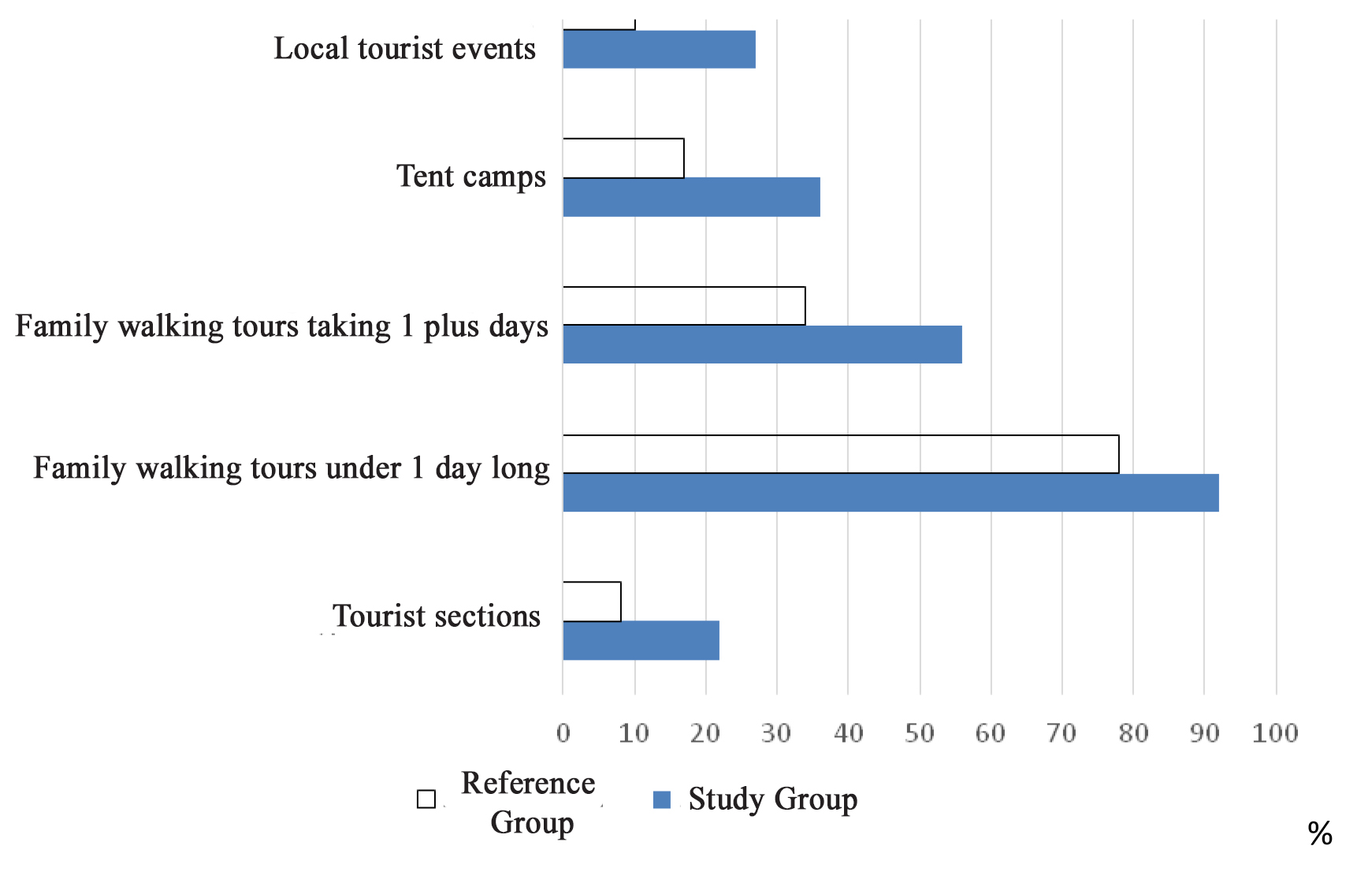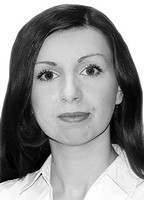Basics of sports and health tourism: optional school course efficiency rating
Фотографии:
ˑ:
Y.A. Karvunis1
Professor, Dr. Med. L.V. Kapilevich1, 2
1National Research Tomsk State University, Tomsk
2National Research Tomsk Polytechnic University, Tomsk
Keywords: sport and health tourism, school children, recreation.
Background. Modern Russian government policies in the people’s recreation sector are dominated by the initiatives to reorient Russian tourist flows from foreign resorts to home tourist destinations [1, 2]. Domestic tourism has evolved to a priority development field for many regions of the country. The sport and health tourism in Russia is considered not only as a recreational phenomenon but also as a mix of cognitive, cultural and physical activities. Historically, this form of tourism has been popular and government-supported for a few periods in the past when due public promotion and institutional initiatives were taken to improve the organized and self-reliant tourism management process and encourage mass tourism and entertainment activities. A special emphasis was made on the effort to lure young people in the sports and health tourism. In 1970ies, for instance, the pan-USSR tourist and local history learning expeditions of school children were regular and traditional. As things now stand, the school education process virtually neglects the cultural and educational potential of domestic tourism [6]. Therefore, in our studies we have given a high priority to the advocacy for the young people’s broader involvement in the local sports and health tourism starting from the school education period [3, 4].
Objective of the study was to analyze the situation with the school pupils’ involvement in different forms of sports and health tourism prior to and after the relevant optional school courses on the basics of tourism.
Methods and structure of the study. We have studied the situation with the school children's involvement in different forms of sports and health tourism; tested the relevant optional school courses on the basics of competitive tourism for secondary schools; and analyzed the study data on the first benefits of the courses. Subject to the study were 240 (128 boys and 112 girls) 5-7-graders from 10 schools (7 urban and 3 rural schools) in the Siberian Region. The study was performed in a few stages in the school years of 2014/2015 and 2015/2016.
Study results and discussion. At the first stage of the study, we obtained and analyzed the questioning survey data to rate the pupils’ involvement in different forms of local sports and health tourism. The survey found that 7.08% of the school students polled attended the tourist groups and sections, and at least 29.1% of the respondents reported having an experience of tourist trips with outdoor overnight stays, normally with their families; and 97.9% of the students polled reported to have been in at least one daily tourist trip. This is explainable by the fact that it is traditional for the local schools to organize team field trips in September, albeit these outings normally give next to no attention to the purely touristic and local history learning aspects.
Based on the study data and analyses we concluded that the mid-age school pupils’ involvement in the tourism focused groups and sections in our region averaged some 7% of the total. This finding was generally supported by the young people’s questioning survey performed in our last study [5].
At the second stage of the study (school year of 2014/2015), 5 schools piloted our optional school courses of the sport and health tourism basics designed for the 5-7 graders of a general education school. The short-term optional school courses were intended to build up the following modules of competences in the trainees:
1) Touristic Techniques Module including tent fixing, right packing of a rucksack, bonfire making, orienteering in an unknown area etc.;
2) Local History Learning Module focused on the regional history and specifics, main tourist attractions and recreation sites etc.;
3) Environmental Module covering the basics of the recreation resource protection and giving frame knowledge of the environmental protection methods, impacts of human activity on environment on the whole and tourist activity in particular etc.;
4) Safety Module giving due knowledge and skills of the tourist process safety rules, awareness of the main risks for the tourists in the region; and the first aid basics;
5) Teamwork Module focused on the abilities to cooperate with and support the team members; and
6) Physical Conditioning Module designed for the body conditioning of the trainees with an emphasis on the competitive/ health tourism aspects.
At the third stage of the study (school year of 2015/2016), we rated the school pupils’ involvement in different sport and health tourism projects prior to and after the optional school courses on sports and health tourism. Subject to the study was the Study Group of 120 people (62 boys and 58 girls) engaged in the course versus the Reference Group of 120 people (66 boys and 54 girls) non-engaged in the course. Given on Figure 1 hereunder are the results of the study.
The study data and analyses showed significant differences in the degrees of involvement in the tourist activity of the SG versus RG as verified by every key criterion. The SG was ahead of RG in the numbers of children (+14) who opted for advanced tourism education for children and youth – their share was estimated at 18.3% in the SG versus 7% in the RG.
Furthermore, rated under the study were the degrees of engagement of the students’ families in tourist activity. Participation rates for the walking tours with overnight stays were estimated at 48% for the SG versus 28% for the RG. The number of children who opted for vacations in tent camps was notably higher in the SG versus the RG. And the number of the participants of the regional tourist events in the study period (including the local tourist festivals, fairs, tourist gatherings etc.) was found twice as much in the SG versus the RG.
Conclusion. The comparative analysis to rate the school children’s involvement in different sport and health tourism projects prior to and after the optional school courses on basics of sports and health tourism showed the courses being effective and beneficial. It is worth mentioning that the children’s growing interest in the tourist activity as a result of the courses was of encouraging effect on the interest of their families to tourism. The short-term optional courses on the basics of sports and health tourism were found to give valuable knowledge and skills to the trainees; contribute to their physical education process; help develop teamwork abilities; and encourage the children’s interest to and involvement in advanced tourist education.
References
- Kalashnikova T.V., Krakovetskaya I.V., Danilova N.E. Upravlenie razvitiem fizicheskoy kul'tury i sporta: finansovy aspekt [Physical culture and sport industry development management: financial perspective]. Teoriya i Praktika Fizicheskoy Kultury, 2016, no. 2, P. 100-103.
- Kalashnikova T.V., Selevich T.S., Krakovetskaya I.V., Ilysheva N.N., Danilova N.E. Ekonomika Rossiyskogo sporta: vyzovy i protivorechiya [Russian sport economy: challenges and contradictions]. Teoriya i Praktika Fizicheskoy Kultury, 2015, no. 8, P. 43-45.
- Karvunis Yu.A., Kapilevich L.V. Sostoyanie i perspektivyi razvitiya aktivnogo turizma v molodezhnoy srede Tomskoy oblasti [State and prospects of development of active tourism among youth of Tomsk region]. Teoriya i Praktika Fizicheskoy Kultury, 2014, no. 10, P. 62-65.
- Karvunis J.A., Kapilevich L.V. Aktivny turizm kak perspektivnaya forma rekreatsii studencheskoy molodezhi v kanikulyarny period [Active tourism as promising form of recreation for students on vacation]. Teoriya i Praktika Fizicheskoy Kultury, 2015, no. 11,
- Karvunis J.A., Kapilevich L.V. Spetsifika fizkul'turno-ozdorovitel'noy i rekreatsionnoy programm v sisteme detsko-yunosheskogo sporta [Specificity of health and fitness programs in children and youth tourism]. Teoriya i Praktika Fizicheskoy Kultury, 2016, no. 2, P. 86-87.
- Neretina T.G., Orekhova T.F., Ovsyannikova E.A., Klevesenkova S.V. Opyt razvitiya studencheskogo dosugovo-ozdorovitel'nogo turizma [Students’ health and recreation tourism promotion experience]. Teoriya i Praktika Fizicheskoy Kultury, 2016, no. 8, P. 41-43.

Figure 1. Children’s rates of involvement in different sport and health tourism activities after the optional courses on the basics of tourism
Corresponding author: kapil@yandex.ru
Abstract
Objective of the study was to analyze the school children’s rates of involvement in different sport and health tourism projects prior to and after the relevant optional school course. Subject to the study were 240 (128 boys and 112 girls) 5-7-graders from 10 schools (7 urban and 3 rural schools) in the Siberian Region. The study was performed in a few stages in the school years of 2014/2015 and 2015/2016. Comparative analysis of the degrees of the pupils' involvement in different sport and health tourism projects prior to and after the relevant optional school courses showed the optional courses being quite effective. It should be noted that there is a certain correlation of the degrees of the children’s involvement in and interest to the tourism-related activity with the relevant interests in their families induced by the children. The short-term optional courses of tourism basics were found to encourage further interest of the pupils to advanced tourism-related education.



